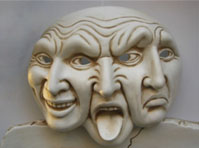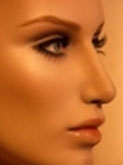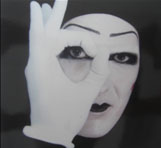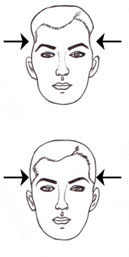|
Practically:
- Forehead wrinkles, lion’s wrinkles and crow’s foot wrinkles: they are treated with botox.
- Upper and lower lips wrinkle: For the deep wrinkles: we use fillers (acid hyaluronic). For the superficial wrinkles: we use the dermabrasion technique.
- The nasolabial folds are treated with fillers (acide hyaluronic, radiesse and fat).
|
 |
|
7. Scar and acne therapies:
Ance and pimples:
Acne is an inflammatory disease of the skin of varying severity and scope, affecting the pilosebaceous follicles (the glands that secrete sebum) at the root of hairs, and resulting in pimples. Regions most affected by acne are the face, neck, décolleté, shoulders and back. Typical forms of acne are seborrhea (oily skin), comedones (microcysts) and blackheads, papules (inflammatory bulges developping on a comedo) which are small and disappear on their own or evolve into pustules (pus lesions), and lastly nodules, the deep inflammatory lesions which eventually burst and leave a scar on the skin.
|

|
|
Dermabrasion:
- Dermabrasion can sometimes improve the appearance of certain superficial scars caused by Acnes.
- Dermabrasion is an ablative treatment using a device with a high-speed rotating wheel that the surgeon moves over raised scarring to smooth it out down to the level of surrounding skin.
- Generally performed under local anesthesia.
- After dermabrasion, a dressing is placed for forty-eight hours and personalized care is prescribed.
- The epidermis regenerates itself in eight days, and the skin.
|
|
Hypertrophic scar (keloid):
abnormal scarring due to overgrowth of scar tissue (excessive production of collagen forming a ridge on the surface of the skin).
The treatment of abnormal and unsightly scars uses different methods:
- Surgical revision: Most often performed under local anesthesia, scar surgical revision involves the removal of the scar and its replacement with another scar whose evolution will be regularly monitored.
- Pressure garments: On certain hypertrophic scars, when surgical revision does not seem interesting, continuous pressure exercized by a suitable dressing or by a tailored garment made of elastic fabric that fits like a second skin, may be successful and lead to a flatter, softer, and paler scar.
- Corticosteroid injection: Injection of corticosteroids is made directly into the scar through a needle.
- Scar massaging: Repeated massages and kneading exert pressures that enhance the involution of keloids or hypertrophic scars and accelerate the natural process of maturation.
|
|
8. Brow lift:
Sometimes the brows sag so much that they need to be lifted. The procedure is under local anesthesia, an incision along the hair line is performed .
|
|
9. Peelings:
There are many different types of peelings: superficial providing a soft, and refreshed look, or a deeper with more important postoperative care.
The type of peeling selected must be adapted depending on the patient's skin.
|

|
|
10. Wrinkle filing:
The non resorbed products are not recommended because they cause lots of complications. The products used are resorbed and degradable products.
They are resorbed from 4 months to 2 years:
- Depending on the product density.
- Depending on the treated area.
- Depending on the severity of the wrinkles.
- Depending on the patient’s skin.
|
|
11. Augmentation of the temporal area :
1-Acid hyaluronic:
The technique consists to inject under local anaesthesia the hyaluronic acid (SubQ), a natural gel of biotechnologic origin, dense, resorbed in 18 to 20 months.
Oedema and hematoma can be seen one week after injection. It is necessary to wait 10 days for an optimal result.
A meeting of correction can be necessary one month later, in order to rectify a light asymmetry or to increase volume.
|

|
|
2- Lipofilling :
This technique consists in obtaining fat from the patient's own body utilizing special cannulas that avoid fat cell destruction. Usually, infraumbilical region is taken as a donor site. The fat is then centrifuged in order to separate the pure fat cells from blood components and triglycerides.
The Fat injection in temporal area is good technique, the operation is under general anaesthesia, and the results are more lasting.
|
|
3-Augmentation of temporal area by insertion of silicone prothesis:
The operation is under general anaesthesia, and the results are lasting.
|
|
12. Laser resurfacing:
The laser treats the wrinkles by abrasion of the surface layers of the skin. The wrinkles of the mouth and the chin are most often treated, as well as the contour of the eyes, the face can be treated in entirety.
The laser light causes in contact with the skin an evaporation of the surface layers with a more or less significant effect of heating of the deep layers carrying out a tensor effect.
Laser CO2:
The laser CO2 causes a more or less major abrasion according to the number of passage on the skin. It requires a local anaesthesia according to the treated zones (eyelids, contour of the mouth, upper lip, etc…) even a general anaesthesia if the whole face is treated.
A preparation of the skin is necessary (creams) 8 to 10 days before the meeting and a social eviction from 1 to 3 weeks after the treatment according to its depth. After treatment, swelling (oedema), seepage during 2 or 3 days, and rednesses can be seen. The bandage is required from 4 to 6 days, then daily care. The redness disappears in several weeks, and requires a make-up and a solar protection.
This laser is indicated in important ageing of solar origin, and in clear skins. One session is necessary.
Duration of the treatment: from 20 minutes to1 hour depending on treated area.
|